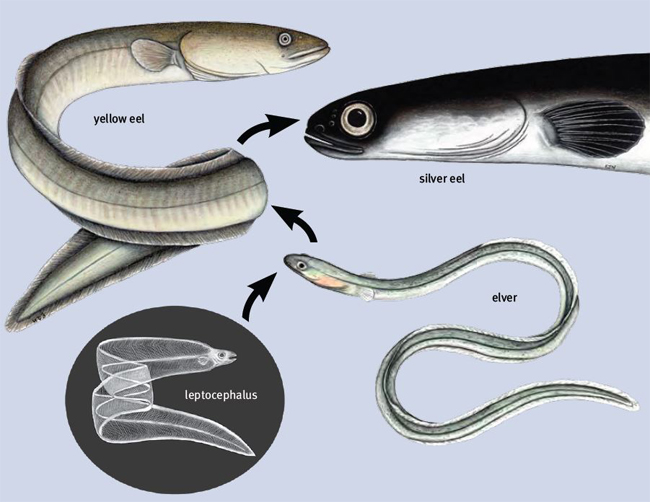Photo: Restoring free-flowing rivers and unrestricted access to a watershed is critical for restoring American eels.
Credit: Ethan Nedeau
Oswego, NY, November 20, 2014 - New York Sea Grant's Fisheries Specialist
Dave MacNeill joined over 30 marine science experts at the University of New England's (UNE) Harold Alfond Forum in mid-October for a two day discussion on the American Eel.
The conference, co-organized by NYSG, attracted these marine experts, eel fishermen and marketing specialists from three countries and over 10 research universities. Other organizers included UNE's
Barry Costa-Pierce, Cornell University's
Michael Timmons and Maine Sea Grant & University of Maine Cooperative Extension's
Dana Morse.
"The idea was to begin forming a strategic partnership that would work together to better understand eel biology, fisheries, and to take steps to develop eel aquaculture," said MacNeill.
Keynote talks were provided by
Ep Eding, a European expert in eel fisheries and aquaculture from Wageningen University in the Netherlands, and from Professor
Ken Oliveira from the University of Massachusetts Dartmouth, who has done pioneering work on the reproductive biology of American eels.

The life cycle of an American eel progresses from a leptocephalus, to a transparent glass eel (not shown), to an elver, to a yellow eel, and finally to a sexually mature silver eel.
Illustrations: Ethan Nedeau
Some of the important findings mentioned at the workshop were:
- A successful management structure called DUPAN of farmers, academics, fishermen exists in Europe to help recover eel stocks there.
- Many unanswered questions on sex differentiation and reproductive biology remain, especially for the American eel, Anguilla rostrata.
- In 2013, Haiti and the Dominican Republic increased their take of glass eels to 5-6 metric tons (MT). Maine’s quota was 5.5 MT (only 4.0 MT were caught), and Canada’s was 7.5 MT.
- In Maine over 900 people have permits to catch glass eels (elvers) in 2013. Nearly all are shipped to China and Korea to be grown in aquaculture ponds and tanks. Prices for elvers in Maine peaked in 2013 at $1,800 to $2,000 per pound but have fallen to $400 to $650 per pound as the Caribbean harvests have increased.
- Eel aquaculture is highly developed in highly intensive systems in the Netherlands. In China it is principally a “mom and pop” pond operation. Eel aquaculture in Korea is growing rapidly.
- Eels have been reported to grow better in saltwater, have a better quality, and are less affected by parasites, but saltwater aquaculture of eels is not practiced commercially.
- Japan eats 70% of the world’s eels; about 98% of this is farmed in China and Korea. Nearly 100% of eels are processed into unagi kabayaki (Japanese style broiled eel) for sushi markets.
- The domestic market for eels in North America is large. About 100, 40’ container loads of eels are imported from China and Taiwan to North America every year.
- Processing North America’s wild adult eels into value-added products such as unagi kabayaki, BBQ eels, and smoked eels makes economic sense. A center in Portland, Maine was considered to be the best place to locate this as it would be equidistant from eel fisheries in Canada and the U.S. Mid-Atlantic states. Significant processing challenges between wild Anguilla rostrata (American eels) and a farm raised Anguilla japonica (Japanese eels) the species currently used for Asian kabayaki production.
- Numerous legal, policy, stock assessment and management questions remain. There is a need for additional applied science and improved stock monitoring and assessments, with substantial investments needed in fieldwork. Cooperative research, establishment of a research set-aside program between academic institutions, regulators, and the eel fisheries communities were two ideas that were mentioned that could help advance the long-term viability of eel fisheries and new aquaculture in North America.
Findings from the workshop are now posted and are regularly updated at
ecologicalaquaculture.org and will be presented at the Northeast Aquaculture Conference and Expo to be held in January 14-16, 2015 at Holiday Inn By the Bay, Portland, Maine. The workshop was funded by the USDA Northeast Regional Aquaculture Center and the University of New England’s Center of Excellence in Marine Sciences.
More Info:
New York Sea Grant (NYSG), a cooperative program of Cornell University
and the State University of New York, is one of 33 university-based
programs under the National Sea Grant College Program (NSGCP) of the
National Oceanic and Atmospheric Administration (NOAA). The NSGCP
engages this network of the nation’s top universities in conducting
scientific research, education, training and extension projects designed
to foster science-based decisions about the use and conservation of our
aquatic resources. Through its statewide network of integrated
services, NYSG has been promoting coastal vitality, environmental
sustainability, and citizen awareness about the State’s marine and Great
Lakes resources since 1971.
For updates on Sea Grant activities:
www.nyseagrant.org has RSS,
Facebook,
Twitter, and
YouTube links. NYSG also offers a free e-list sign up via
www.nyseagrant.org/coastlines for
NY Coastlines, its flagship publication, which merged with our e-newsletter,
Currents, in 2014 - is published several times a year.